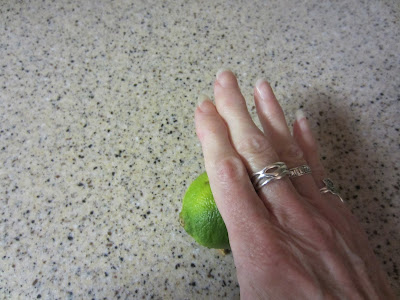This recipe is so good. I changed the name to Lime Bread from Lemon Bread because today when I made it, I used fresh lime juice. I love it with fresh lemon juice, but I really love it with fresh lime juice.
We bought the limes at a roadside market in CO on the way home after visiting our son and his family recently. I wanted to use them but I keep forgetting to use them in my iced tea. This morning I decided I would just squeeze the juice from them and store the juice in the frig. (Don't miss the tips below for getting the juice from fresh lemons and limes.)
As I said, I used lime juice instead of lemon juice. Feel free to use lemon juice if you want a lemon flavor. If you decide to use lemon juice instead of the lime juice, also add 1-1/2 teaspoon lemon peel. I made 2 generous mini-loaves instead of a large single loaf. I will freeze one for later and enjoy one now.
LIME LOAF
1/2 cup light margarine (1 stick)
1 cup sugar (or 1/2 cup truvia blend)
2 eggs
1-2/3 cup all-purpose flour
3/4 cup buttermilk
1/2 teaspoon baking soda
1/4 teaspoon salt
1/3 cup chopped nuts
3 tablespoons lime juice
1 tablespoon sugar
Spray two mini-loaf pans or one 8 x 4 x 2-inch loaf pan.
Preheat oven to 350 degrees F.
In a large mixer bowl, beat butter on medium speed about 30 seconds or til softened.
Add 1 cup of sugar; beat about 3 - 5 minutes or til light and fluffy.
Add eggs, one at a time, beating after each til combined.
Blend flour, baking soda, and salt with whisk in a small bowl.
Add dry mixture and buttermilk; beat til moistened.
Stir in nuts.
Pour batter in pans.
Bake for 40 minutes or til a toothpick inserted near center comes out clean.
Remove from oven and set on wire racks.
Mix the lime juice and tablespoon of sugar and stir to dissolve sugar.
Poke holes in the bread while in the pans with a meat fork or ice pick, etc.
Spoon the lime/sugar mixture over the bread in the pans.
Cool for 10 minutes on wire racks.
Remove from pans and continue to cool on wire racks.
TIP ALERT!
I had had the limes in the refrigerator for a week and I wanted to make sure that I got all of juice from them.
I was familiar with two different methods and decided to try both.
One thing you can do if the limes or lemons are at room temperature, is roll them along the counter to soften it.
If the limes or lemons are cold (as mine were), place them in the microwave and heat for 20-30 seconds to warm them slightly.
After I took them out, I rolled them on the counter, too, to soften.
The next thing I did was new to me (I did some research). Cut across the fruit from end-to-end instead of around the middle.
Then I squeezed the half with my hands over the measuring cup
And then I used my glass juicer-thing.
I was really pleased....from the six limes, I squeezed a cup of lime juice.



















































